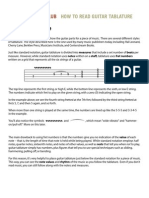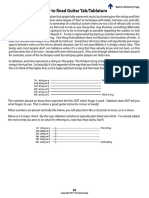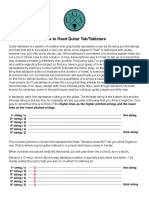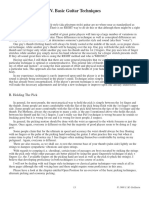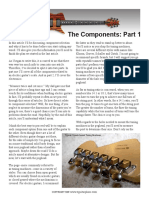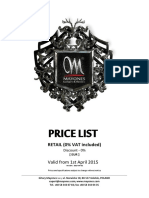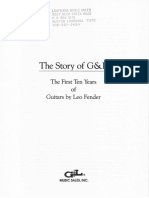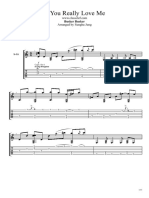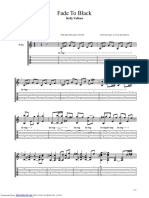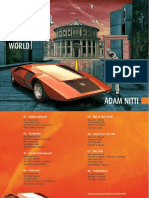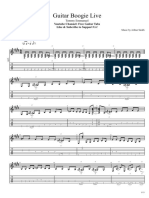GETTING STARTED Picks: I recommend the use of a thumb pick and 3 metal finger picks.
This
allows for the broader spectrum of dynamics which is desirable when you are playing delta and piedmont style blues.
Place the thumb pick on the thumb of your picking hand (if you are right handed you will pick the strings with the fingers of that hand) in a manner that the "band" portion of the thumb pick is equally straddling the point on the thumb where the flesh meets the fingernail. Find a thumb pick that fits snugly on the thumb so that you feel confident the pick will not slip off when you play aggressively (refer to photographs) Take the finger picks and one at a time, size them to fit your Index Finger, Middle Finger, and Ring Finger. Bend the "band" portion of each of the metal finger picks to fit the size, shape and contour of each of the fingers. When they are sized and shaped, further compress them so that they will fit very tightly. A tight fit here will allow you to play very aggressively without feeling like the picks will work their way off of your fingers. Make sure you have the pick portion of the fingerpicks on the underside of your fingers.
The Slide should remain on the "pinkie" finger of the fretting hand at aII times when you are in any of the open tunings, unless otherwise indicated. Although you will not be using the slide in the first few exercises, it is important that you get used to holding it. *The finger is bent inside the slide holding it in place, thereby preventing it from bouncing around while your hand is in motion. *The Slide should always remain parallel to the line of the frets.
*Place the slide directly over the fret to generate the note that you would fret with fingertips in between the frets.
*Always have the middle finger of the fretting hand resting on all six strings behind the slide to dampen harmonic overtones. .More on the use of the slide as we proceed. (refer to photographs)
�Holdine The Guitar
We will be employing some elements of classical guitar technique, beginning with the way we will hold the guitar (see photos ). Hold the guitar body between your thighs, with the neck of the guitar tilted upward at the appropriate angle per photo. Use of a footstool is recommended to elevate the left foot several inches. We will be outlining a number of other points as we continue along, including the fact that we will want to keep the thumb of the fretting hand behind the neck at aII times, unless specifically indicated otherwise. A good rule is that someone sitting directly across from you should not be able to see the thumb of the hand, which is fretting the guitar (refer to photographs).
In general we will be employing what we will refer to as a Default Right Hand Position which seryes as a Primary Reference Point so that we can develop a sense of distance perception in the picking fingers to pick the strings accurately. The Default Right Hand Position affords us with 3 Contact Points with the instrument, which we use as reference points to develop the sense of distance perception required to pick the strings accurately. We will begin working in Open G Tuning.
�TUNINGS: from 6rH lthickest) to 1sr lthinnest string)
Open G Tuning:
Open
DGDGBD DADF#AD EADGBE
D Tuning:
Standard Tuning:
The 3 Contact Points of Default Risht Hund Positon are:
*Right Forearm resting on body of guitar *Right Palm resting on 6th string bridge pin or cover plate strap *Fingers Resting on their assigned strings (refer to photographs)
Note that if you are playing aflattop guitar, the right hand palm will rest on the sixth string bridge pin. If you are playing a resonator guitar, the right hand palm will rest on the cover plate strap. The part of the palm we're referring to is the indentation just above the joint.
will also be employing what we refer to as our Default Right Hand Mode (4FM). In this mode, we are picking the strings with four fingers (Thumb; Middle; Index; and Ring) and will also indicate this on tablature
We
as
4FM.
Pickine Assienment In The Default Risht Hq.nd Mode (4FMl
*Ring Finger will pick only the l,'to or thinnest string.
*Middle Finger will pick only the 2nd string.
*Index Finger wilt pick only the 3'd string. *Thumb will pick 4th, 5th, &
(refer to photographs) We will also be using another right hand assignment for picking strings (3FM) whereby we will employ a 3 Finger Mode (refer to photographs). In 3FM we will drop the ring finger out of the picture, and reassign the
6th
strings.
�middle finger to pick the 1't string and the index finger to pick the second string. The reason we refer to 4FM as the Default Mode is that we will remain within the parameters of the four-finger assignment unless specifically indicated to move to 3FM. We will occasionally use 3FM for passages where more power or speed is required, and will then return to the Default 4FM after these passages have been executed.
Secondary Reference Points:
In addition to the Default Right Hand Position, as mentioned before, affording us with 3 contact points with the instrument which we use as reference points for distance perception to pick the strings accurately, we will also be using a variety of secondary reference points. This Secondary Reference Point consists of having the inactive fingers of the Right Hand (those which are not currently picking a string or strings) either resting on their assigned strings, or on their way back to the appropriate resting point. Obviously, this secondary reference point is constantly changing and sounds more difficult to grasp than it actually is. When you get to the Metronome Bass Exercise (Lesson 2) and Shuffle (Lesson 3) you will begin to apply this concept in a simple manner and should find no difficulty continuing to
expand upon the idea as we proceed onward.
NOTE: FOR THE AUDIO EXPLANATIONS WE HAVE USED A FORM OF VERBAL SHORTHAND.
ALL CHORD SHAPES OR NOTE POSITIONS ARE
VERBALIZED IN THE SAME MANNER.
EXAMPLE: I@THE FIRST, RING
I WILL ALWAYS CALL OUT A NOTE POSITION OR CHORD SHAPE IN THE SAME SEQUENCE, FIRST CALLING OUT THE STRING NUMBER, NEXT CALLING OUT THE FRET AT WHICH IT IS FRETTED, THEN INDICATING THE
FINGER WHICH IS FRETTING THE NOTE. *STRING NUMBER / *FRET i *FINGER FRETTING.
�Tablature:
We will be numbering the strings 1-6, with string 1 being the thinnest string and string 6 being the thickest string. Tablature is a simplified form of alternative musical notation which is akin to "paint by numbers" in approach. It is very effectively used for both standard tuning and a variety of open tunings and you will become accustomed to working with it very quickly. It is read from left to right, with each vertical line representing an instant in time. You play the note or notes indicated on one vertical line, then the note or notes on the next vertical line, one vertical line (note position) after another.
A Staff consists of 6 horizontal lines running across the page from left to right. Each of these lines represents a string of the guitar.
*The Top Line represents the
1.'t
or thinnest string.
*The Bottom Line Represents the 6th or thickest string.
*Tablature does not speci$r the rhythmic delivery; it merely shows a sequence of notes to be played one after another. Subsequently it is helpful to have some familiarity with the music.
*To the left of the first staff of each Tab you will see letters representing the notes the open strings are tuned to, thereby indicating in which tuning each
piece is to be played.
*A vertical line in tablature represents an instant in time.
If
more than one note is on a vertical line (note position) in the tablature, this indicates that they are to be played simultaneously.
When 2 note positions are indicated on adiacent strings in the same vertical line (note position) both notes will be picked brushing the strings simultaneously with one finger Qticking pairs). When 2 note positions are indicated on non adiacent strings in the same vertical line (instant in time) they will be picked simultaneously with two different fingers picking, bearing in mind the specffic assignment of a given finger to pick a given string in either 4FM (Default Mode) or 3FM.
�I also use aform of verbal shorthand in my private instruction, which
greatly expedites communicating a note position or chord shape. In this "verbal tablature" I always call out a note position in the same sequence. First calling the string number, Secondly calling the fret at which it is to be fretted, and Thirdly calling out the finger of the left hand which will be
fretting the note.
Tablature Symbols:
0 - indicates that the string is to be played open. 1 (or any other number) - indicates that the string is to be played while fretted atthat particular fret number.
Arrow pointed upward with Y+ indicates to bend the string.
PM above note position indicates that the note or notes should be damped after you have played and heard them. For our purposes here we will use this PM symbol as a generic damping symbol. We will learn 5 different
damping methods in this introductory course and will outline the parameters for the use of a given damping method for different scenarios. Notes - Ghost Notes Bracketed notes are called ghost notes. This indicates that the note in brackets is fretted, but not played at this point in time. You can bet that the reason the note is indicated as a ghost note usually tells us that we will likely be playing that note in short order, so subsequently we elect to form a fuIl chord, although we are not yet playing all of the notes which are fretted.
( ) Bracketed
Vibrato
This symbol above a note position indicates that note will be held to sustain with vibrato. More about vibrato shortly forthcoming.
�X - Muffled Note indicates that the note or notes are to be picked while fully damped. Much of this type of material employs this technique as a percussive effect, often picking pairs of damped notes with the thumb pick. Pulloff - P -A bracket connecting two notes with a P over it represents pulloff. You pick the first note, then pulloff with the slide (or finger,
whichever the case may be) thereby generating two notes picking the string only once. Hammer-On - H - A bracket connecting two notes with an H over it represents picking the first note, then hammering onto the second note, thereby generating two notes picking the string only once.
Natural Harmonics - NH - This symbol indicates generating note by lightly touching the string directly over the l2th fret.
a harmonic














